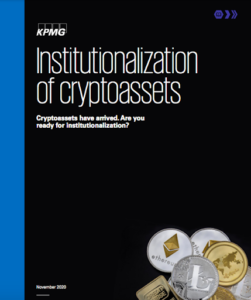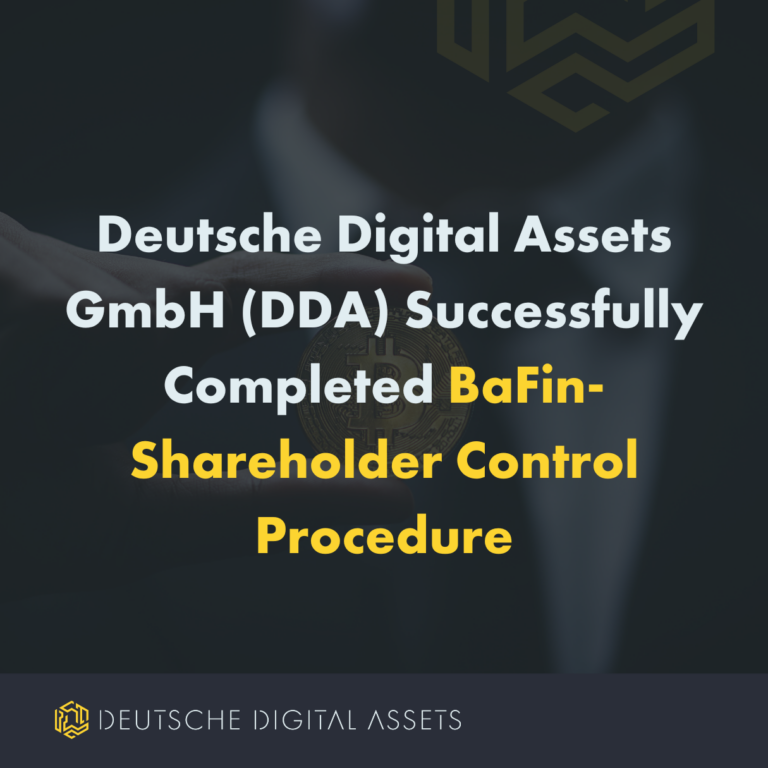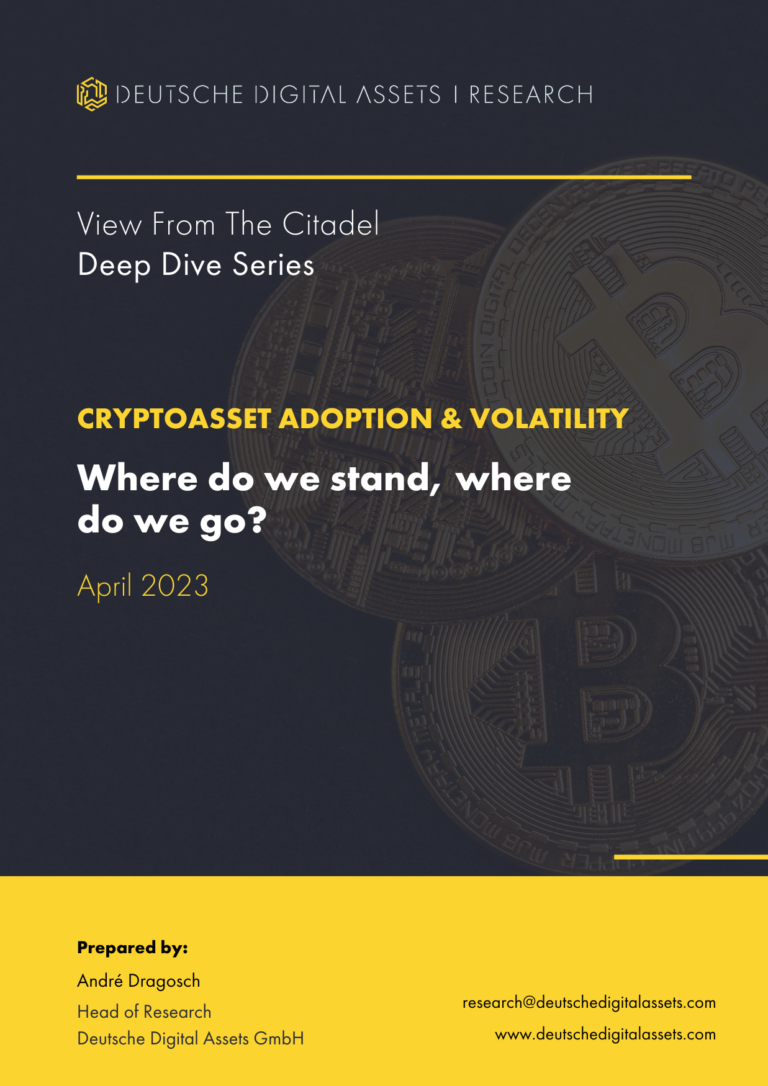Unlike other asset classes, crypto assets began with retail trading, not adoption by institutions. Early adopter crypto funds soon followed. Now it’s the turn of institutional investors: the institutionalization just began.

The Importance of Institutionalization
80% of equity market capitalization is held by institutions. So it is not surprising that institutionalization is essential if digital assets are to scale, as stated by KPMG, the Big Four auditing firm, in a report published last November titled “Institutionalizationof Cryptoassets.”
“Institutionalization is the at-scale participation in the crypto market of banks, broker dealers, exchanges, payment providers, fintechs, and other entities in the global financial services ecosystem,” the report says.
“Institutionalization . . . is required to build trust, facilitate scale, increase accessibility, and drive growth,” the report continues.
“Interestingly, even though there are large price fluctuations with Bitcoin, it is not inherently volatile. The supply is in fact fixed and algorithmically secured. It is the demand that is fluctuating, and this could eventually stabilize as the market matures,” the report adds.
The values, writes Jeff Horowitz, Coinbase’s Chief Compliance Officer, in the same report, is the opportunity crypto assets represent to transform the financial industry into a truly open global financial system.
What will give cryptoassets staying power, the report asserts, is their ability to reduce friction and inefficiencies within the global economy.
Challenges for Institutionalization
 In addition to the need to comply with laws and regulations, KPMG cites the gap between use cases and development execution as a major challenge for institutionalization: more than 2,000 significant cryptoassets already exist but most have no functional product.
In addition to the need to comply with laws and regulations, KPMG cites the gap between use cases and development execution as a major challenge for institutionalization: more than 2,000 significant cryptoassets already exist but most have no functional product.
Four important use cases listed are: Bitcoin as a digital store of value, Ethereum as a means to raise funds, Litecoin as a cheap and fast peer-to-peer medium of exchange, and the tokenization of traditional assets.
The KPMG Solution
As one would expect, KPMG has developed a solution to propose to crypto businesses that want to scale while addressing the challenges — a comprehensive framework of nearly 20 components.
Promising Outlook
Prospects for attracting institutional investors to cryptoassets are favorable.
In May 2019, Fidelity Investments, the fifth-largest asset manager in the world, released findings that showed why institutional investment in cryptoassets is likely to grow significantly over the next five years. Fidelity surveyed 441 institutional investors — such as endowments, financial advisors, hedge funds and pensions — from November to February on their outlook on crypto investing.
- 22% of respondents have already purchased cryptocurrency — a remarkable increase from near-zero in 2016.
- 40% of respondents said that they are open to future investments in digital assets in the next five years
- Nearly half of respondents — 47% — said that they see a place for digital assets in their investment portfolios.
In terms of how they invest, Fidelity found that 72% prefer purchasing investment products that hold or represent digital assets, such as futures, while 57% choose to purchase cryptocurrency directly or to buy equity in digital asset-related companies.
Institutional Engagement is Here
Actions speak louder than words, and major institutions are stepping up to the plate. Here are three examples:
-
Fidelity Investments
Fidelity has already taken the lead. It launched Fidelity Digital Assets to build “the technical and operational capabilities needed for securing, trading and supporting digital assets with the exacting oversight required by institutional investors.” In early 2019, it announced it was beta testing its trading and custody solutions with a “select set of eligible clients.” -
Bakkt
Bakkt, a digital asset exchange from Intercontinental Exchange (ICE), owner of the NY Stock Exchange, was expected to launch late last year and is now scheduled for late this year. It will be one of the first cryptocurrency trading platforms backed by an institution. Bakkt will also launch physically settled Bitcoin futures. The platform is expected to bring in a large number of institutional investors by providing them with a regulated ecosystem for investing in and securely storing cryptoassets. -
The First Pension Fund Investments
Conservative institutions, led by two pension funds, funded a new Morgan Creek crypto-focused venture fund to the tune of $40 million in February 2019. Morgan Creek is an asset manager targeting institutional clients and family offices. The two public pensions anchoring the fund are Fairfax County, Virginia’s Police Officer’s Retirement System and Employees’ Retirement System. Other fund investors include a university endowment, a hospital system, an insurance company and a private foundation.
The size of the two pension funds illustrates the potential of pension funds for crypto investing. The police pension fund has $1.45 billion in assets; the employees fund has $4.25 billion.
Morgan Creek’s investment opportunities will be primarily sought in equity, though the fund will be open to a limited number of security token opportunities that provide cash flow provided they comply with Reg D. The investment portfolio will be thoughtfully structured to meet the needs of established investors with a long view, according to Anthony Pompliano, partner at Morgan Creek Capital.
Crypto Funds
Investment funds already play a critical role in institutional investing, with an estimated 60% of institutions’ assets under management in hedge funds. The funds add value by enabling investors to diversify efficiently into non-correlated asset classes and by introducing asset managers with the experience to manage risk and the skills to optimize returns.
Crypto funds can be expected to be even more important for institutionalizing crypto asset investments. Why? Because the crypto asset space is all new and even more difficult to navigate than traditional investing. In addition, it still has more than its share of scams.
It’s early days for crypto funds, but they’re growing rapidly. The first annual crypto hedge fund report by PWC Elwood estimates the number of crypto hedge funds at 150, most of them small. Over 60% have less than $10 million in AUM, with fewer than 10% managing over $50 million. However, a number have over $100 million, according to the report.
By comparison, Hedge Fund Research estimates the number of hedge funds at nearly 10,000 as of the end of 2017. The largest of which, Bridgewater, had $124.7 billion in AUM.
Emergence of the Crypto Asset Management Industry
Iconic Holding is playing a leadership role in helping to give birth to the new crypto asset management industry with the Iconic AMaaS solution — Asset Management as a Service. — which will launch in Q3 2019.
Iconic experienced the challenges crypto asset managers face first-hand issuing its first crypto index funds last year.
The company found enterprise-grade service providers few and far between in crypto. That leaves managers to cobble together the least of the evils for the major capabilities a crypto fund requires. Then, they need to figure out how to get them to work together harmoniously as a whole.
The complexity of the need was far greater than could be met by a software platform. It encompasses:
- Market data
- Custody
- Trade execution
- Liquidity
- Audit
- Compliance
- Banking
- Fund administration
So to develop its own index fund infrastructure, Iconic built a network of licensed crypto service provider partners. Then, it connected them via API to create an interoperable ecosystem that functions seamlessly through a single digital portal. Asset managers showed interest in this framework. Therefore, Iconic decided to make it a market offering for any would-be crypto asset manager. The hope is that AMaaS will dramatically speed the set-up and optimize the operation of compliant crypto funds, lowering pricing — and, in the doing, accelerate institutionalization of crypto asset investing.
Conclusion
Will a substantial number of institutional investors be able to find a reliable and trustworthy environment in the crypto space within, say, the next five years?
Could a large percentage of financial assets become digital within, say, the next ten years?
Will the use of digital assets via the blockchain actually produce increased transparency, openness and auditability pivotal to a fairer and more open economy?
It could happen!













